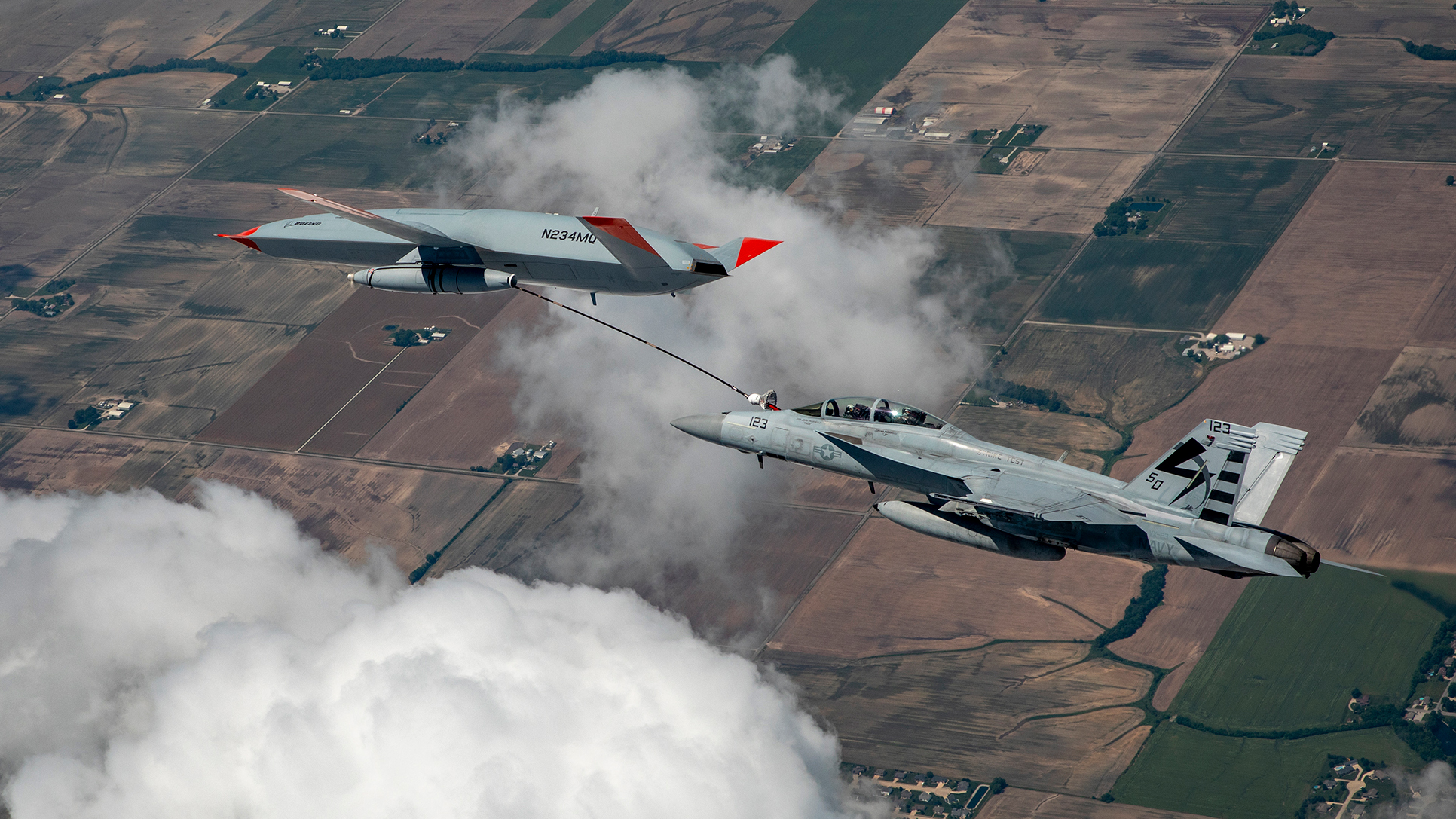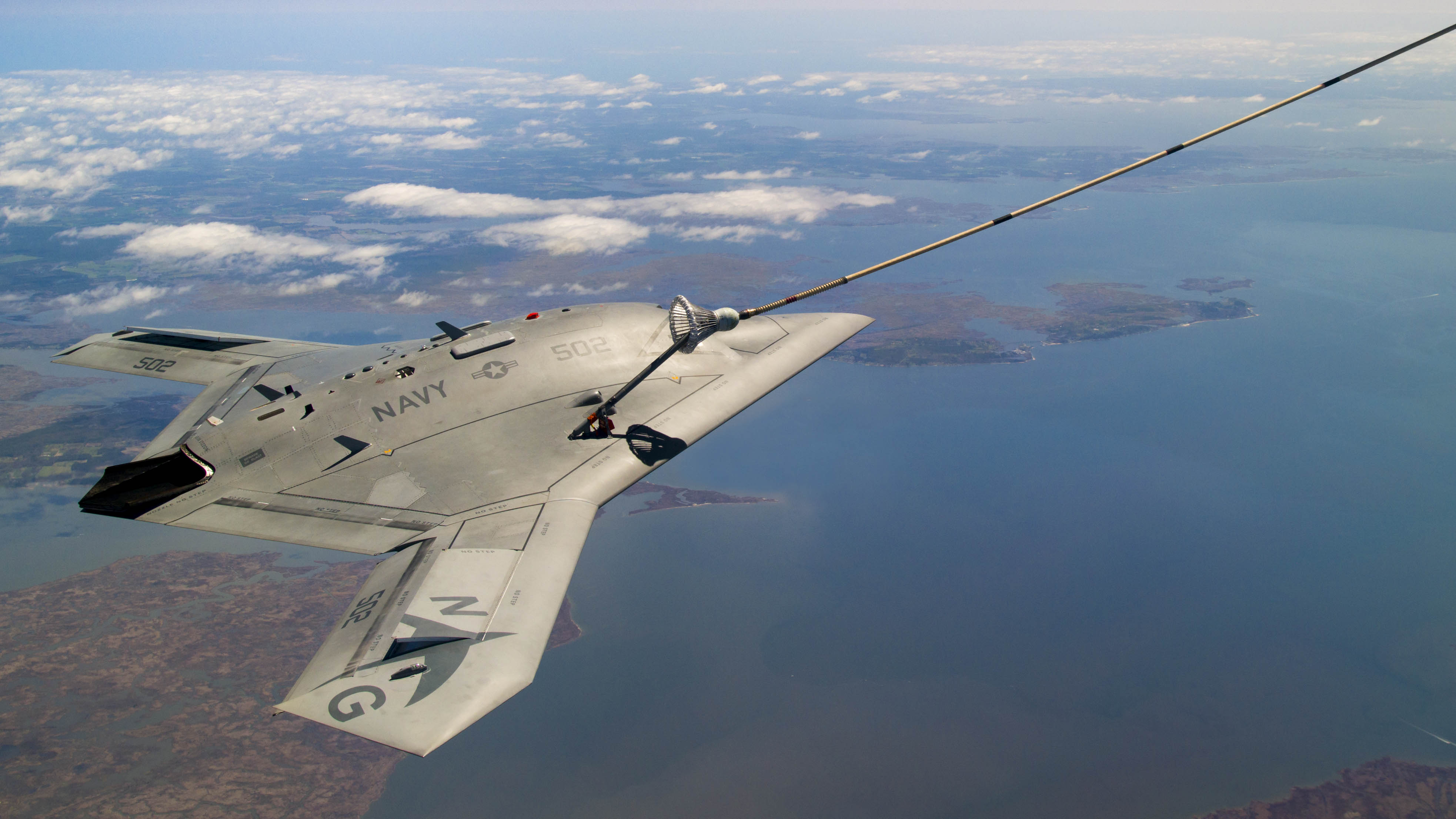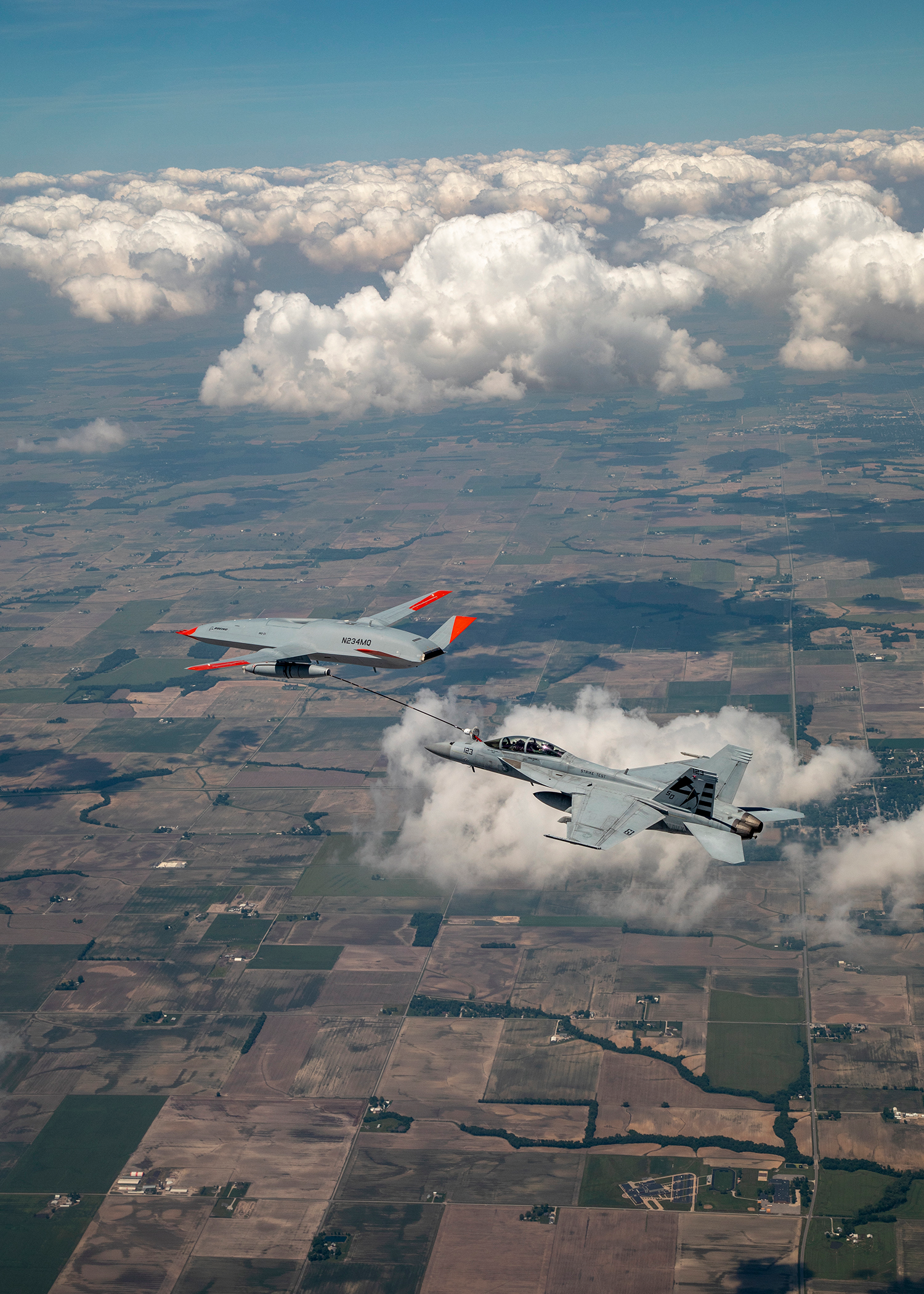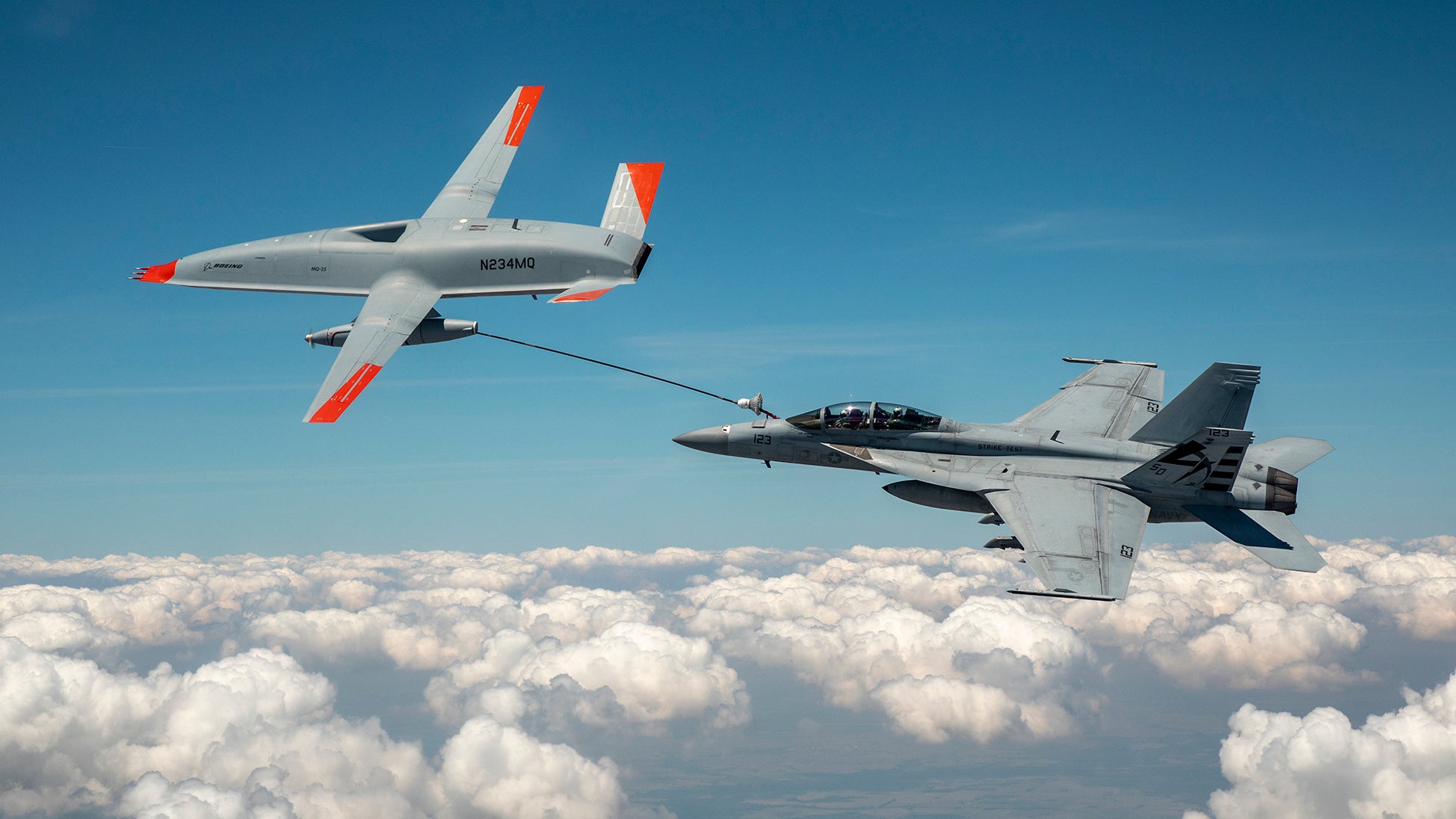Boeing’s MQ-25 Stingray test asset, known as T1, has conducted the first successful aerial refueling of a manned receiver aircraft by an unmanned tanker. The landmark is a vital one as the U.S. Navy looks forward to adding the MQ-25 to its carrier air wings, or CVWs, in the future.
The Navy’s Naval Air Systems Command (NAVAIR) and Boeing announced today that the T1 test article had demonstrated its tanker capability with an F/A-18F Super Hornet jet fighter on June 4, 2021. The drone had flown from MidAmerica Airport in Mascoutah, Illinois. The MQ-25 demonstrator aircraft passed fuel to the Super Hornet using an Aerial Refueling Store (ARS) mounted under its wing.

As well as the fighter actually ‘plugging in’ to the drone to receive fuel, the same test mission involved evaluation of formation flying between the manned and unmanned assets, with as little as 20 feet separation between the two. Other test points included tracking the drogue — the basket-like assembly trailed by the MQ-25 that connects with a receiver aircraft’s standard refueling probe. Both aircraft were flying at operationally relevant speeds and altitudes, according to Boeing.

“This flight lays the foundation for integration into the carrier environment, allowing for greater capability toward manned-unmanned teaming concepts,” said Navy Rear Admiral Brian Corey, head of the Program Executive Office for Unmanned Aviation and Strike Weapons. “MQ-25 will greatly increase the range and endurance of the future carrier air wing — equipping our aircraft carriers with additional assets well into the future.”
“This history-making event is a credit to our joint Boeing and Navy team that is all-in on delivering MQ-25’s critical aerial refueling capability to the fleet as soon as possible,” said Leanne Caret, President and CEO of Boeing Defense, Space & Security. “Their work is the driving force behind the safe and secure integration of unmanned systems in the immediate future of defense operations.”
“This is our mission, an unmanned aircraft that frees our strike fighters from the tanker role, and provides the carrier air wing with greater range, flexibility and capability,” added Navy Captain Chad Reed, program manager for the Navy’s Unmanned Carrier Aviation program office (PMA-268). “Seeing the MQ-25 fulfilling its primary tasking today, fueling an F/A-18, is a significant and exciting moment for the Navy and shows concrete progress toward realizing MQ-25’s capabilities for the fleet.”
The first fuel transfer between the MQ-25 and a manned aircraft was used to collect various data relating to airwake interactions — how aerodynamic flows between the two platforms behave — as well as the reliability of guidance and control systems. With the data gathered, the test team will examine whether any changes needs to be made to the drone’s flight control software.
While the June 4 demonstration is the first time in history that air-to-air refueling of a manned aircraft has been accomplished with an unmanned tanker, the concept of using drones in refueling operations is not without precedent.
In 2015, Northrop Grumman and the Navy successfully demonstrated fully autonomous aerial refueling using the X-47B Unmanned Combat Air System Demonstration (UCAS-D) drone, which refueled in flight from a contractor-operated Boeing 707 tanker. That was the first time an unmanned aircraft had been refueled in-flight.

Prior to that, in 2012, DARPA’s Autonomous High-Altitude Refueling program demonstrated fully autonomous aerial refueling of unmanned air vehicles at high altitude. This culminated with two modified RQ-4 Global Hawkdrones flying in close formation to test probe-and-drogue contacts, as seen in this video:

The first refueling sortie for the MQ-25 demonstrator was the 26th for the T1 test vehicle but there has also been extensive simulations of aerial refueling using MQ-25 digital models.
According to NAVAIR, “Testing with T1 will continue over the next several months to include flight envelope expansion, engine testing, and deck handling demonstrations aboard an aircraft carrier later this year.” The first carrier that will be adapted to operate the aircraft is the Nimitz class USS George H.W. Bush (CVN-77).
The MQ-25 has been flying with the ARS pod since last December 9, when T1 made a previous test flight at MidAmerica St. Louis Airport. The drone performed its maiden flight from the same location in September 2019. The ARS, developed and produced by Cobham, is the same store that’s carried by U.S. Navy F/A-18 Super Hornets that presently fulfill the carrier-based tanker mission.
Previous test footage of the MQ-25 with the ARS pod:

“MQ-25 Stingray extends CVW mission effectiveness range, partially mitigates the current Carrier Strike Group (CSG) organic ISR shortfall, and fills the future CVW-tanker gap, mitigating strike fighter shortfall and preserving F/A-18E/F fatigue life,” the Navy latest budget request explains.
Beyond the tanker mission, the Navy also plans for the MQ-25 to undertake intelligence, surveillance and reconnaissance (ISR) taskings, as well. There are also some indications that the MQ-25 could take on additional missions as time goes on, as well, something The War Zone has explored in the past.
Nevertheless, the scope of the MQ-25’s overall capabilities are still much more modest than the previous Unmanned Carrier Launched Airborne Surveillance and Strike (UCLASS) program. That was intended to yield a low-observable drone able to penetrate sophisticated air defenses and then undertake strike and persistent ISR missions. That said, the MQ-25 demonstrator was reworked out of the UCLASS effort and does retain at least some of the low-observable features of that original, more demanding requirement, including the novel flush-mounted intake.
Meanwhile, as a dedicated test vehicle, the MQ-25 T1 is not necessarily representative of the definitive Stingray drone. A first batch of four Engineering and Manufacturing Development (EMD) aircraft are also being completed under a 2018 contract award. Last year, the Navy handed Boeing a contract modification for another three MQ-25s. As well as the tanker/ISR mission set, these aircraft will provide the Navy with experience of its first carrier-based drone of this size and capability and will be used to “demonstrate mature complex sea-based C4I UAS technologies, and pave the way for future multifaceted multi-mission UAS’s to pace emergent threats,” according to the Navy.

Over the next few years, Boeing will deliver the EDM aircraft for testing at the company facility in St. Louis, Missouri before transiting to Naval Air Station Patuxent River, Maryland, for the rest of the flight test program, although there will also be tests undertaken at Lakehurst, New Jersey, and Eglin Air Force Base, Florida.
However, while a first EDM aircraft was scheduled to be delivered this year, the MQ-25 program has run into some delays. According to the Navy, these include a “pause” in design work to optimize weight and strength, an unspecified quality issue identified during the build process, plus the effects the COVID-19 pandemic impacting the manufacture and delivery of parts from suppliers. With that in mind, it’s not currently clear when the first of the EDM vehicles will be handed over. Regardless, flight testing of that aircraft is not now expected to begin until sometime in Fiscal Year 2022.
Ultimately, the Navy plans to field 72 MQ-25s, the first of which are expected to deploy with the fleet in an initial operating capacity in Fiscal Year 2025, a process that’s set to be eased by attaching the drones to E-2 squadrons, with Hawkeye crews cross-training to also fly the Stingrays.
For now, at least, the first aerial refueling mission by the MQ-25 demonstrator is the latest important milestone in the service’s push toward its first-ever operational carrier-launched unmanned aircraft capability.
Update, 12.30 PM PST:
At a joint Boeing and U.S. Navy media round table, Captain Chad Reed, program manager for the Navy’s Unmanned Carrier Aviation program office (PMA-268), and Dave Bujold, Boeing MQ-25 program director, provided some more details about the historic June 4 refueling sortie, involving the T1 test article for the MQ-25 program and an F/A-18F from Air Test and Evaluation Squadron Two Three (VX-23).
The flight had a total duration of around 4.5 hours and the formation work began with the F/A-18F, flown by two Navy operational test pilots, moving into a standard observation position on the drone, checking the hose and drogue. Once the Super Hornet was lined up in a pre-contact position the MQ-25 operator on the ground — in radio contact with the F/A-18 — withdrew the basket. The fighter jet then got “substantially closer” to the drone for the wake survey. The test pilots reportedly confirmed that the effects of the drone on the fighter were very benign, with a high degree of stability.
The F/A-18 then backed off and T1 deployed the hose and drogue, as the Super Hornet pilots checked the perspective. This included evaluating their view of the drogue, which is otherwise deployed from under the centerline of the strike fighter, but is offset under the wing of the drone. The first actual contact was a dry connect, with no fuel flowing, followed by a wet contact at 10,000 feet.
Since T1 does not actually feature plumbing between the wing tanks and the ARS, there was only the 500 pounds of fuel available in the refueling pod to transfer. A total of 300 pounds of fuel was delivered before another transfer was conducted at 15,000 feet, this time involving a considerably smaller quantity, around 25 pounds.
In all, in excess of 10 minutes was spent conducting wet contacts, with a longer period for the dry hookups.
Captain Reed explained that over the next six months it’s planned for T1 to undertake a carrier demonstration as well as expand the receiving aircraft to include the E-2. For the deck trials, the T1 will be loaded onto a carrier in port, and then used for deck-handling work, since it’s not equipped for catapult launch or arrested recovery. That last point is interesting, since it was originally built with this capability.
Bujold confirmed that the first EMD aircraft is now expected to be delivered in the fall of 2022. This should not be significantly different from the T1, externally at least, since it will share the same mold line, as well as the same Rolls-Royce AE 3007N turbofan engine, albeit in a navalised form.
Currently, EMD-1 is in production in St. Louis, Missouri, alongside one of two static test specimens, in addition to the seven EMD aircraft now on order. Initial operating capability is currently set for early 2025.
Contact the author: thomas@thedrive.com
